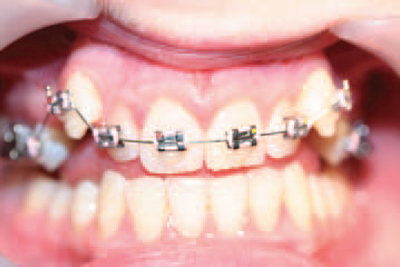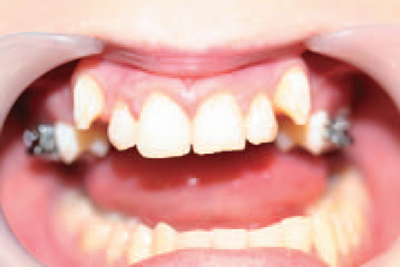SECTION 11
TOOTH ALIGNMENT WITH ORTHODONTIC BRACES

REASON FOR PROCEDURE
Although a patient’s desire for straight teeth is usually based on aesthetics, there are several dental advantages to aligning uneven teeth. Crooked and crowded teeth provide many potential areas for plaque to accumulate that would not exist if the dental arch was well aligned (see Figure 11.1). It will take a consistently high standard of oral hygiene for life in these cases to prevent any carious or periodontal damage from occurring with time, as each crooked tooth and crowded area will require individual attention during every toothbrushing session.
When teeth are severely crowded, they sometimes do not bite together sufficiently well for the patient to chew food efficiently, and, in very severe cases, where the jaw sizes do not match, the patient may also experience speech difficulties. These severe cases often benefit from a combined approach of orthodontics and jaw surgery.
Figure 11.1 Crowded upper teeth requiring orthodontic treatment

When the bottom jaw bites too far behind its normal position, the upper anterior teeth will appear to project forwards quite prominently (proclined), and these upper teeth will be vulnerable to trauma or even fracture by being so positioned.
Finally, the psychological well-being of a patient should be considered in severe cases, when malocclusion may be responsible for excessively low self-esteem or the cause of childhood teasing or even bullying.
The simplest techniques used for tooth alignment are:
- Removable appliances
- Fixed appliances
REMOVABLE APPLIANCES
Background information of procedure
Removable appliances are made from an acrylic base with metal attachments to provide retention, similar to acrylic dentures. They have additional metal components incorporated as necessary to carry out the required tooth movement to be achieved, and these include a variety of springs, screw devices or adjustable metal bars.
These components are checked and adjusted by the dentist on a regular basis to effect the tooth movement.
When severe crowding is present in the dental arch, it may be necessary for tooth extraction to be carried out before an appliance is fitted. This creates the space required to reposition the other teeth and align the arch.
The amount of movement possible with a removable appliance is sufficient in many cases to fully correct malaligned teeth, but the force applied is limited by the fact that the appliance is removable – if too much force is applied, the brace is not stable in the mouth. It is then that a fixed appliance is required.
Whichever type of appliance is planned, many new plaque retention areas will be created in the patient’s oral cavity, and it is imperative that a consistently good standard of oral hygiene and diet control is practised throughout the course of orthodontic treatment.
Poor oral hygiene is the main factor preventing many patients from being offered orthodontic treatment, no matter how great their need.
Details of procedure
The dentist carries out an oral and radiographic assessment of the patient beforehand, and determines the orthodontic treatment required and the appliance necessary to achieve it by taking study model impressions and studying the ca/>
Stay updated, free dental videos. Join our Telegram channel

VIDEdental - Online dental courses


